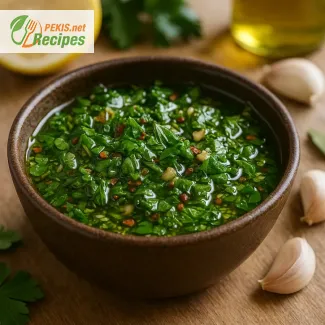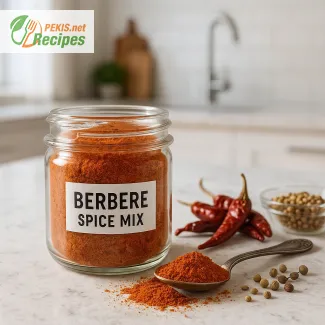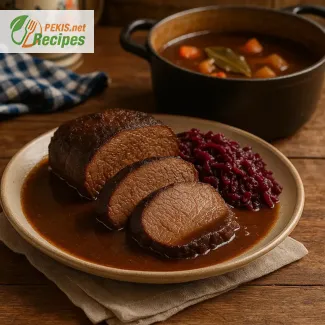
Discover the Essence of Argentinian Flavor with Traditional Chimichurri
A vibrant herb-based condiment that transforms grilled dishes into culinary masterpieces
When it comes to authentic Argentinian cuisine, few condiments hold as much cultural and culinary significance as chimichurri. This herbaceous, tangy and aromatic sauce is a staple across Argentina and Uruguay, traditionally served alongside grilled meats—especially beef, which is at the heart of the South American barbecue tradition known as asado. But beyond its roots in open-fire cooking, chimichurri has gained global popularity for its freshness, versatility, and the way it elevates even the simplest grilled dishes.
This chimichurri recipe delivers more than just bold flavor—it represents an entire philosophy of cooking: one that values natural ingredients, bold seasoning, and straightforward preparation. Whether you’re preparing a weekend barbecue or looking to enhance a weeknight steak, this homemade chimichurri sauce brings zesty, herb-forward flavor to your table in just minutes.
The cultural heritage behind chimichurri
An Argentinian classic with humble beginnings and global appeal
The origins of chimichurri are deeply embedded in the gaucho tradition of Argentina. Gauchos—nomadic horsemen of the Pampas—relied on simple but flavorful condiments to complement their open-fire meats. Chimichurri, with its base of parsley, garlic, olive oil, vinegar, and red chili flakes, became the ideal partner for grilled steak, lamb, sausages, and even vegetables.
Its uncooked, oil-based nature makes it a vibrant marinade, a dipping sauce, or a table condiment. Its simplicity is deceptive: each ingredient plays a distinct role in balancing acidity, heat, freshness, and umami. The bright green color and bold aroma signal its potent freshness, which adds depth without overwhelming the main dish.
Why chimichurri belongs in every modern kitchen
A simple sauce that enhances everything from grilled meats to roasted vegetables
Today, chimichurri sauce is not only beloved in Latin America but also across North America, Europe, and beyond. It’s a prime example of a versatile condiment that transcends its origins. Home cooks and chefs alike reach for chimichurri when they want to add fresh, bold flavor without the use of dairy, sugar, or heavy sauces.
Its oil-and-vinegar base, combined with fresh herbs and aromatics, makes it ideal for low-carb, keto, paleo, and vegan diets. It's naturally gluten-free and adapts well to ingredient substitutions based on availability or preference. Whether spooned over a grilled ribeye, tossed with roasted potatoes, or swirled into mashed avocado, chimichurri proves to be one of the most adaptable sauces in modern cooking.
The secret to perfect chimichurri flavor balance
Fresh ingredients, proper ratios, and a short resting time make all the difference
At its core, chimichurri is about balance. The earthiness of fresh parsley, the pungency of raw garlic, and the heat from red chili flakes are all brought together by tangy vinegar and the silkiness of olive oil. For best results, it’s essential to use flat-leaf parsley, fresh garlic cloves, and a good-quality olive oil. The vinegar—traditionally red wine vinegar—adds the necessary acidity to cut through rich grilled meats.
Letting the sauce rest for at least 20–30 minutes before serving allows the flavors to meld. This brief waiting time is crucial to softening the rawness of garlic and enhancing the harmony between herb and acid. While chimichurri is often made fresh just before a meal, it also stores well in the refrigerator for up to a week—allowing its flavor to deepen even further.
Chimichurri variations around the world
From spicy red versions to herb medleys, this sauce inspires creativity
Although the traditional green chimichurri verde remains the most iconic, many regions have developed their own interpretations. The red chimichurri, or chimichurri rojo, incorporates smoked paprika, tomato paste, or roasted red peppers for a sweeter, more complex flavor profile. Other adaptations include the use of oregano, cilantro, or even mint, depending on the desired freshness or intensity.
In Brazil, Uruguay, and parts of Mexico, chimichurri has taken on regional inflections that still honor its Argentinian origins. Despite these variations, what remains consistent is the sauce’s raw preparation, its balance of acidity and fat, and its role as a powerful flavor enhancer for grilled, roasted, or sautéed foods.
Chimichurri's place in contemporary grilling and meal prep
A modern essential for elevating simple dishes with minimal effort
In today’s kitchens—whether in suburban backyards or professional restaurant grills—chimichurri stands out as a must-have sauce. Its ease of preparation, natural ingredients, and bold character make it perfect for anyone looking to enhance their grilling repertoire. Because it works as both a marinade and finishing sauce, chimichurri shortens prep time while maximizing taste.
Its vibrant green color and bold texture also make it a photogenic addition to food presentations, loved by food bloggers and culinary professionals alike. Whether drizzled over charred vegetables, juicy steak, or a grain bowl, chimichurri adds a burst of freshness and a signature Argentinian flair that continues to win over palates worldwide.
1. Chop the herbs and garlic.
Finely chop the fresh parsley and oregano using a sharp knife (avoid food processors to maintain texture). Mince the garlic as finely as possible.
2. Mix the dry ingredients.
In a medium bowl, combine the chopped parsley, oregano, minced garlic, red chili flakes, sea salt, and black pepper.
3. Add the liquids.
Pour in the red wine vinegar and freshly squeezed lemon juice. Stir gently to combine and allow the mixture to sit for 2–3 minutes so the herbs start to absorb the acidity.
4. Incorporate the olive oil.
Slowly drizzle in the olive oil while stirring constantly until the ingredients are fully coated and well distributed. The sauce should be loose but not separated.
5. Let the sauce rest.
Cover the bowl and let the chimichurri rest at room temperature for 20–30 minutes before serving. This helps the flavors meld and develop complexity.
6. Serve or store.
Use immediately as a topping for grilled meats such as steak, lamb, or chicken. Chimichurri can also be used as a marinade. Store leftovers in an airtight container in the refrigerator for up to 5 days. Stir well before each use.
Elevate Your Chimichurri: Ingredient Tweaks and Flavor Strategies
Small changes that bring depth, balance, and personalized flair to the classic Argentinian sauce
The classic chimichurri recipe is a masterclass in simplicity—fresh parsley, garlic, red wine vinegar, olive oil, oregano, and chili flakes—blended into a bold green sauce. But behind its minimalist ingredient list lies a vast opportunity for customization and refinement. Whether you're cooking for dietary preferences, exploring regional inspirations, or aiming to enhance its complexity, chimichurri can evolve into a deeply personalized culinary signature.
How ingredient choices affect balance and character
Fine-tune flavors by adjusting acidity, heat, and herbal notes
One of the simplest ways to enhance your chimichurri is by adjusting the acidity. Traditional recipes rely on red wine vinegar, but swapping it for sherry vinegar adds a slightly sweeter, more rounded flavor, while white balsamic vinegar lends subtle fruitiness without overpowering the herbs.
For those who prefer less sharpness, adding a touch of lemon zest or juice alongside or in place of vinegar can brighten the sauce while mellowing the acidic bite. This is especially useful when pairing chimichurri with lighter proteins like grilled chicken or white fish.
If you're seeking bolder heat, increase the red pepper flakes or incorporate a small amount of fresh red chili. Conversely, for milder palates, reduce the chili or use smoked paprika to add depth without heat, transforming your chimichurri into a smoky, earthy version ideal for roasted vegetables or seared mushrooms.
Fresh herbs: substitutions and expansions
Parsley is the base, but other herbs can enrich or refocus the profile
Flat-leaf parsley is essential for that grassy, vibrant base. However, blending in other herbs can add dimension. Cilantro, common in Latin American cooking, adds a citrusy, slightly peppery quality. A small amount of fresh basil brings sweetness, perfect for pairing with lamb or Mediterranean dishes.
For a more herbal-forward twist, try adding fresh mint, which pairs beautifully with grilled lamb or eggplant. But be careful with stronger herbs—add sparingly to avoid overpowering the sauce.
Always use fresh herbs, not dried. Dried parsley or oregano can introduce a bitter note and compromise the vivid color and fresh flavor that define good chimichurri.
Enhancing texture and mouthfeel
Oil quality and garlic treatment influence smoothness and intensity
Not all olive oils are created equal. A high-quality extra virgin olive oil, cold-pressed and peppery, will lend both smooth texture and complexity. Avoid blends or refined oils, which lack the same flavor integrity.
For a gentler garlic flavor, roast the garlic cloves before mincing, or briefly soak raw garlic in vinegar before combining. This softens the pungency while preserving depth, which helps the sauce appeal to a broader range of tastes.
Some chefs also add a small spoonful of shallots or minced red onion, which builds aromatic sweetness and softens the bitterness of fresh herbs—especially helpful if your parsley is mature or fibrous.
Make chimichurri more nutritious or allergy-friendly
Healthy substitutions and adjustments for dietary needs
The traditional sauce is already naturally gluten-free, dairy-free, and vegan, but it can be optimized further. Consider using avocado oil instead of olive oil for a higher smoke point and a more neutral flavor. This is useful if you're using chimichurri as a marinade for high-heat grilling.
For sodium-sensitive individuals, reduce the sea salt and amplify flavor with a dash of umami-rich tamari or nutritional yeast flakes—both deepen the taste while lowering salt content.
To boost nutritional value, blend in baby spinach or kale. These not only enrich the color and texture but add valuable vitamins like folate, iron, and vitamin K. Just ensure the added greens are finely chopped to maintain the rustic, hand-crafted consistency of authentic chimichurri.
Mistakes to avoid when making chimichurri
Common errors that affect flavor, texture, and preservation
One of the biggest pitfalls is over-processing the herbs. Using a blender or food processor can result in a pasty, overly emulsified texture that lacks the sauce’s signature rustic character. Always chop herbs by hand to maintain structure and prevent bitterness from over-bruised leaves.
Another error is using low-grade vinegar or stale garlic, which can overpower the delicate herbal notes. Always opt for fresh ingredients and avoid artificial flavorings or ready-made herb blends.
Lastly, don’t skip the resting time. Chimichurri needs at least 20–30 minutes to develop flavor, allowing the herbs, acid, and oil to blend into a cohesive, vibrant sauce.
Why homemade chimichurri is always superior
Control, freshness, and creativity make the difference
Store-bought versions often include preservatives, excess sodium, and diluted oils that mask the authentic taste. Making chimichurri from scratch allows full control over ingredients, balance, and dietary considerations. Plus, the texture and flavor of freshly made chimichurri are unmatched—bright, intense, and perfectly suited to your specific meal.
Whether you keep it classic or experiment with bold variations, a homemade chimichurri lets you express both tradition and creativity with every spoonful.
Allergens present in the recipe:
- None (naturally free from gluten, dairy, nuts, soy, and eggs)
Substitution tips to remove allergens and gluten:
- No substitutions needed – this recipe is naturally free from common allergens and gluten.
Vitamins and minerals per serving (approximate):
- Vitamin C: 12 mg – supports immune function and iron absorption
- Vitamin K: 160 µg – essential for blood clotting and bone health
- Vitamin E: 2.2 mg – contributes to antioxidant protection of cells
- Iron: 1.1 mg – important for oxygen transport in the blood
- Potassium: 90 mg – regulates fluid balance and supports heart function
- Calcium: 35 mg – supports bone and dental health
Antioxidants per serving (approximate):
- Lutein + Zeaxanthin: 1,300 µg – support eye health and reduce oxidative stress
- Oleuropein (from olive oil): 4 mg – exhibits anti-inflammatory and cardiovascular benefits
- Flavonoids (from parsley and oregano): 12 mg – protect against cellular damage and aging processes





